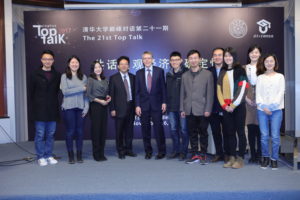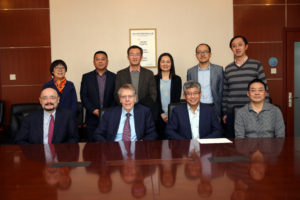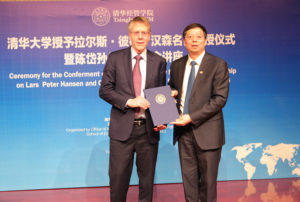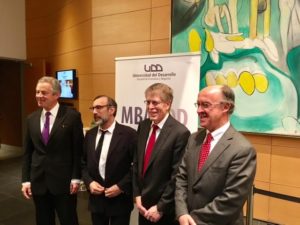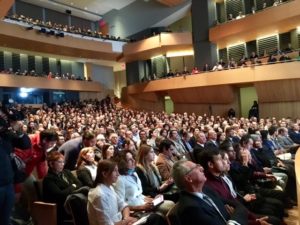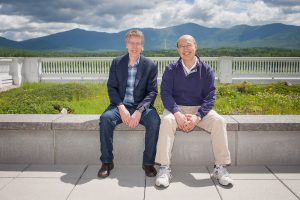I just returned from a trip to South Korea. I spoke for the first time at a Mont Pelerin Society (MPS) meeting. The MPS was originally formed by Friedrich Hayek, Ludwig von Mises, Frank Knight, Milton Friedman, George Stigler and others. My father-in-law, S. C. Tsiang was an early member, having worked with Hayek while studying at the London School of Economics during World War II. I can only speculate about the interesting intellectual exchanges that took place in early meetings of the society. While there was a common commitment to the importance of economic freedom as a central part of social philosophy, there were likely some basic disagreements about the productive approaches to economic analyses.
It was quite fitting for the conference to be held in South Korea. The economic performance of South Korea since the end of the Korean War has seen truly spectacular and dramatic contrasts to its northern neighbor. Economic freedom and a market economy were vital contributors to this success. Previously, I had visited Seoul and been impressed by the vibrancy of the capital city, but after the meeting, my wife Grace and I headed to the southern regions of the country including Busan, and we found the city to be truly beautiful and stunning, while located in the midst of some elegant forested mountains.
The conferences had some memorable sessions. Vaclav Klaus, who served as the second President of the Czech Republic, pointed to the challenges in Europe stemming from its formation of an economic and monetary union without a corresponding political and fiscal union. He doubted the value of open immigration in such circumstances and expressed concerns about immigrants in search of entitlements. Coming from the US, I have had a rather different perspective on immigration. Virtually all of my ancestors were very poor, with little if any property, saw little opportunity in their home countries during the mid-1800s. While converting to Mormonism, they viewed immigration to the US as a new start. They were seeking opportunities and not entitlements and worked hard after immigration to support their families and communities. This ancestral background and my pleasure in interacting with so many young and impressive scholars from other countries make me very concerned about a highly restrictive immigration policy. But as an economist, I certainly agree that we should be cognizant of structuring good incentives for people who seek to immigrate.
Perhaps my favorite session was one in which my former colleague, Jacob Frenkel, along with John Taylor and Jerry Jordan participated. All three talked about monetary economics. Jacob has had a three-pronged career, first establishing himself as an elite international economist and followed by important public and private sector roles. This broad perspective was reflected in his talk ending with a reminder of the potential adverse consequences of the sustained low short-term interest rates and nonstandard recent monetary policy initiatives. Like me, this was Jacob’s first MPS meeting. John, in addition to being a prominent academic economist, also served in the public sector. I liked very much John’s point that the more license monetary policy authorities take to broaden their policy toolkit and innovate, the less compelling is the argument to grant them considerable independence in their conduct of policy. He called not only for clarity in their policy objectives but also in the means to achieve those objectives. Jerry Jordan discussed the potential gains of currency competition making specific reference to crypto currencies and their impact in the future.
General Burwell Bell, a distinguished and retired four star general, gave one of the most memorable talks. He provided an informative presentation from the standpoint of someone who has a first-hand view of the military and political situation of South Korea for years while undergoing an important economic transformation. He reminded us of the rather delicate political situation that South Korea has and continues to find itself in given the military might of its neighbors, China and North Korea.
In my talk I covered some of the themes in my recent paper, “The Economic Analysis of Uncertainty and Uncertainty in Economic Analysis.” This builds on recent work I have been doing with Tom Sargent and others. I use insights from a variety of literature to study the consequences of uncertainty when conceived of in general terms, broader than is typical in economics analyses. I discussed implications for the behavior of asset prices and speculated about how it could provide a more sober perspective on economic policy. In terms of discussing policy, I drew on insights of both Friedman and Hayek.
In the same session, Vernon Smith drew some fascinating connections between some experimental results and perspectives of Adam Smith. More peculiar to me was the talk by Israel Kirzner, who, by drawing in part on the Austrian tradition of Mises and others, criticized the neoclassical treatment of profit and entrepreneurial activity with specific reference to Milton Friedman. While there is considerable scope for building more interesting models of rewards for searching and developing new productive opportunities, I failed to see the fundamental flaw in viewing some component of profit as rents or returns to entrepreneurial skills. I would have preferred to see a constructive critique of how to build more revealing models.
Hayek and Mises were referred to continually throughout the conference. Hayek was at the University of Chicago from 1950 to 1962, well after he had written his fundamental book on “The Road to Serfdom.” Interestingly, his appointment was in the Committee of Social Thought and not the Economics Department. Hayek received the Nobel Prize in Economic Sciences in 1974 along with Myrdal in an apparent balancing act by the committee. The paper attached to his Nobel address is a remarkable one. He sketches the limits to economics as a science and the limited use of mathematics beyond a language of clarity. He was critical of econometrics and its formal attempts at quantification and measurement and wrote:
“Indeed, the chief point was already seen by those remarkable anticipators of modern economics, the Spanish schoolmen of the sixteenth century, who emphasized that what they called pretium mathematicum, the mathematical price, depended on so many particular circumstances that it could never be known to man but was known only to God. I sometimes wish that our mathematical economists would take this to heart. I must confess that I still doubt whether their search for measurable magnitudes has made significant contributions to our theoretical understanding of economic phenomena – as distinct from their value as a description of particular situations. Nor am I prepared to accept the excuse that this branch of research is still very young: Sir William Petty, the founder of econometrics, was after all a somewhat senior colleague of Sir Isaac Newton in the Royal Society!”
Given the repeated references to Misses and Hayek and the skepticism of the formal use of mathematics to support quantitative investigation, I found it particularly interesting and challenging that I was a featured speaker. I mentioned this in my introduction. While I find Hayek’s writings on social and economic philosophy to be thoughtful and at times provocative, I find my research ambition as an economist is better aligned with the vision captured in the front end of Friedman’s Nobel lecture.
I had some valuable conversations with the current President of the MPS, Peter Boettke, who while having intellectual ties to Austrian economics continues to seek productive and thoughtful connections to a variety of recent research. I had an enjoyable breakfast with the most recent past president of the MPS, Pedro Giron, who is an economic historian. His talk and our informal conversation were informative and gave me a better perspective on the contrasts between Austrian economics and the economic perspective that I am more familiar with at the University of Chicago, including Friedman and Becker, who were both prominent members of the Society.
At the end of the conference, Grace and I had a delightful dinner with three former students: WooKyu Park, Jong Park and Kiseok Lee along with an longtime friend of Grace’s, Claudia Rosett, who is an economics writer of considerable note and someone who has been a regular participant in past MPS meetings.
Overall, this was a fascinating trip, and one that expanded my horizons.

